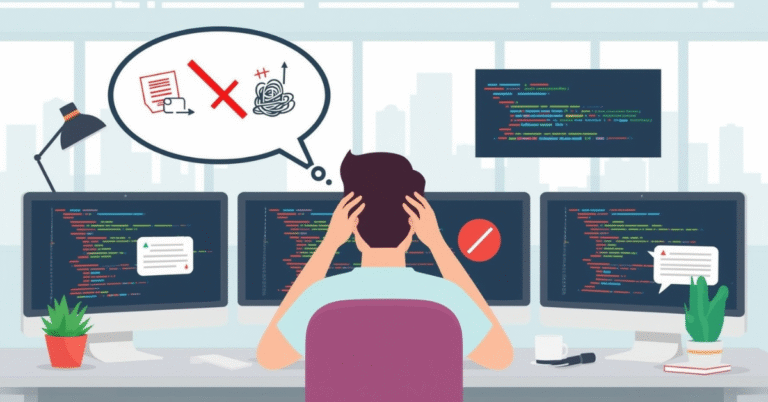
Micro-Frontends in 2025: Are They Worth the Hype?
1. Introduction: Why Micro-Frontends Matter More Than Ever
In 2025, modern web applications have grown into massive, complex ecosystems. From e-commerce platforms to SaaS dashboards, teams are struggling to keep codebases manageable and deployment cycles fast.
Micro-frontends — an architectural style where a front-end app is split into smaller, independently deployable modules — promise to solve these challenges by giving teams autonomy, reducing bottlenecks, and improving scalability.
But the question remains: are they worth the hype, or are they just another fleeting trend in front-end architecture?

2. What Are Micro-Frontends?
Micro-frontends take the same principles of microservices — splitting back-end systems into independent, manageable pieces — and apply them to the front-end.
Instead of one giant codebase, your application is divided into smaller, self-contained frontend modules. Each module can:
- Be built with its own tech stack (React, Vue, Angular, etc.).
- Have its own deployment pipeline.
- Be maintained by independent teams without affecting the rest of the app.
In practice, this means your checkout page, search bar, user dashboard, and settings panel could all be separate micro-apps that seamlessly integrate into a single user interface.
The key benefits are team autonomy, faster deployments, and scalability — but they also introduce new challenges like inter-module communication and performance optimization.

Unlock exclusive, detailed insights with our free downloadable PDF—your ultimate companion to mastering this topic.
3. Why Micro-Frontends Are Trending in 2025
Micro-frontends aren’t new — early adopters experimented with them as far back as 2016. But in 2025, the concept has surged in popularity for a few very specific reasons:
1. Complex Applications Demand Modular Solutions
Modern apps aren’t just a few static pages — they’re dynamic ecosystems with dozens (sometimes hundreds) of interactive features. A single-page app for an enterprise SaaS platform might have a user dashboard, analytics visualizations, reporting tools, integrations, and chat support — each of which could be a standalone app in itself.
Micro-frontends allow these components to evolve independently without risking downtime or requiring massive regression tests every time one feature changes.
2. Multi-Team Development Is the New Norm
In large organizations, development teams are often distributed across countries, time zones, and even outsourced partners. A monolithic frontend becomes a bottleneck because everyone is committing to the same codebase.
With micro-frontends, teams can work in parallel, choosing their own frameworks, release schedules, and CI/CD pipelines, then merge everything into a unified UI at runtime.
3. Tech Diversity Without Full Rewrite Costs
In traditional setups, introducing a new front-end framework means refactoring the entire codebase — a massive undertaking.
With micro-frontends, a single feature can be built using a new framework without rewriting the rest of the application. This makes tech adoption incremental instead of disruptive.
4. Edge Deployment and Performance Gains
Thanks to advancements in edge computing and CDN-based delivery, micro-frontends can be deployed closer to the user, improving load times and reducing latency. Features like personalized content or localized UIs can be loaded on demand rather than bundled into a single, heavy JavaScript payload.

4. Benefits and Drawbacks — The Balanced View
Like any architectural choice, micro-frontends aren’t a magic bullet. They bring some compelling advantages, but they also introduce unique challenges that can’t be ignored.
✅ Benefits of Micro-Frontends
- Team Autonomy & Faster Delivery
Each team can own its own feature end-to-end — from design to deployment — without waiting for approvals from a central monolithic team. This speeds up releases and encourages innovation. - Independent Scaling
Not all parts of an app have the same performance requirements. Micro-frontends let you scale only the parts that need it — for example, scaling the checkout flow during sales without affecting the rest of the app. - Incremental Tech Adoption
New frameworks, libraries, or UI paradigms can be introduced gradually without rewriting the entire application. This reduces tech debt and allows for smoother migrations. - Fault Isolation
If one micro-frontend fails, it doesn’t necessarily take down the entire application — improving resilience and uptime.
⚠️ Drawbacks of Micro-Frontends
- Increased Complexity in Communication
Features often need to share data, and managing inter-module communication can become tricky without proper design patterns. - Potential for UI Inconsistency
Independent teams may use different UI libraries, leading to inconsistent design unless strict style guidelines are enforced. - Performance Overhead
Loading multiple bundles instead of one can increase initial load time if not optimized carefully. - Higher Operational Overhead
Each micro-frontend might have its own build pipeline, deployment process, and monitoring setup — increasing DevOps workload.
The Verdict
In 2025, micro-frontends are worth considering if you have large teams, complex applications, and the operational maturity to handle distributed architectures. For small teams or simpler apps, the overhead may outweigh the benefits.

5. Best Practices for Implementing Micro-Frontends in 2025
Adopting micro-frontends is more than just breaking your UI into smaller parts — it requires careful planning, a solid governance model, and the right tooling.
1. Start with a Domain-Driven Design (DDD) Approach
Before breaking things apart, identify clear domain boundaries. Each micro-frontend should serve a distinct business capability — for example, “Checkout,” “Search,” or “User Profile” — rather than splitting by technical concerns. This keeps ownership clear and reduces interdependencies.
2. Standardize Communication Between Modules
Use a well-defined API contract or event bus for communication between micro-frontends. This ensures that updates in one module don’t unintentionally break another. Popular choices include custom events, message buses, or GraphQL gateways.
3. Enforce a Shared Design System
To avoid UI fragmentation, create a centralized design system (e.g., via Storybook) that all micro-frontends consume. This guarantees visual consistency even if modules are built with different frameworks.
4. Optimize for Performance Early
Since micro-frontends often require multiple JavaScript bundles, use techniques like lazy loading, code splitting, and prefetching to minimize initial load times. Consider deploying critical features at the edge for faster delivery.
5. Automate Deployment Pipelines
Set up independent CI/CD pipelines for each micro-frontend to allow teams to deploy autonomously. Integrate automated testing at every stage to avoid regressions.
6. Monitor and Log at the Module Level
Implement per-module logging and monitoring to quickly detect which micro-frontend is causing performance issues or errors. Tools like Datadog, New Relic, or OpenTelemetry can be integrated at the component level.
Pro Tip:
If you’re starting fresh, try implementing micro-frontends with Module Federation in Webpack or newer bundler-native solutions like Vite’s federated modules — they simplify runtime integration.

6. Future of Micro-Frontends — Trends to Watch Beyond 2025
The micro-frontends movement is far from static. As front-end tooling, hosting platforms, and AI-powered development evolve, we’re seeing exciting trends that could redefine how micro-frontends are built and delivered in the coming years.
1. AI-Generated Frontend Modules
By 2027, it’s likely that AI tools will be able to generate entire micro-frontend modules from business requirements. Imagine describing your “checkout flow” in plain English, and your AI assistant delivering a ready-to-deploy micro-frontend complete with design, logic, and API integrations.
2. Universal Module Federation Standards
Today, integration often relies on framework-specific solutions (like Webpack Module Federation). The future may bring standardized, framework-agnostic protocols for sharing UI components across applications — making it easier to mix and match tech stacks.
3. Edge-Native Micro-Frontends
As edge computing becomes the default, micro-frontends could be compiled and deployed directly to edge locations, reducing latency to near zero. This will make real-time personalization and localized content delivery seamless.
4. Self-Healing and Auto-Updating Modules
With the rise of observability and AI monitoring, future micro-frontends might detect when they are malfunctioning and automatically roll back to a stable version or patch themselves without human intervention.
5. Server-Driven UI Hybrid Models
While client-side micro-frontends dominate now, server-driven UI (SDUI) could merge with micro-frontend principles — allowing the server to decide which modules to render, optimizing performance and adaptability.
6. WebAssembly-Powered Micro-Frontends
WebAssembly (Wasm) will enable micro-frontends to be written in any programming language, compiled to Wasm, and run in the browser at near-native speed. This could blur the lines between front-end and back-end capabilities.

FAQS
Q1: Are micro-frontends suitable for small teams or startups?
Not always. For smaller applications or teams, the overhead of managing multiple deployments, codebases, and communication patterns may outweigh the benefits. A monolithic front-end might be more efficient until scale demands otherwise.
Q2: Can I mix different JavaScript frameworks in micro-frontends?
Yes. One of the main advantages is framework flexibility. You could have one module in React, another in Vue, and a third in Svelte — as long as you have a clear integration method (such as Web Components or Module Federation).
Q3: What’s the main performance challenge with micro-frontends?
The biggest challenge is often bundle size and load time. Without optimization techniques like lazy loading and code splitting, micro-frontends can cause slower initial renders.
Q4: How do micro-frontends handle shared state?
Shared state should be managed via APIs, global event buses, or centralized state management systems like Redux Toolkit with cross-module communication patterns. Avoid tightly coupling modules.
Q5: Will AI make micro-frontends obsolete?
Unlikely. AI will help automate their creation, testing, and integration — but the architectural concept of independent, modular front-ends will still be relevant for scalability and resilience.







